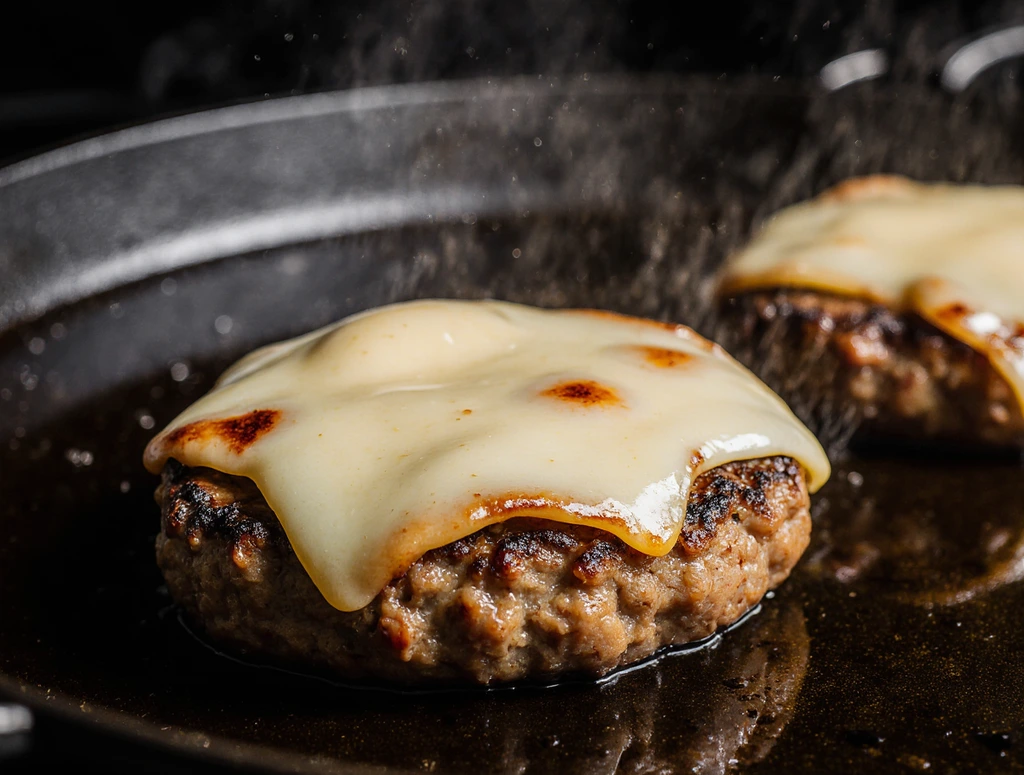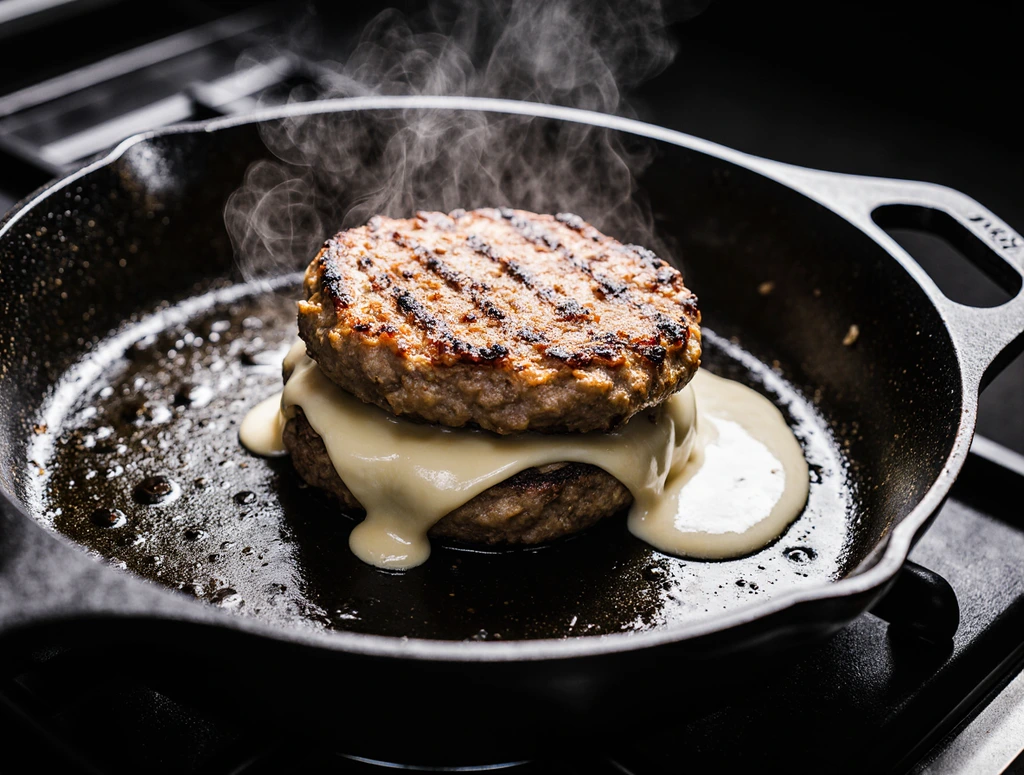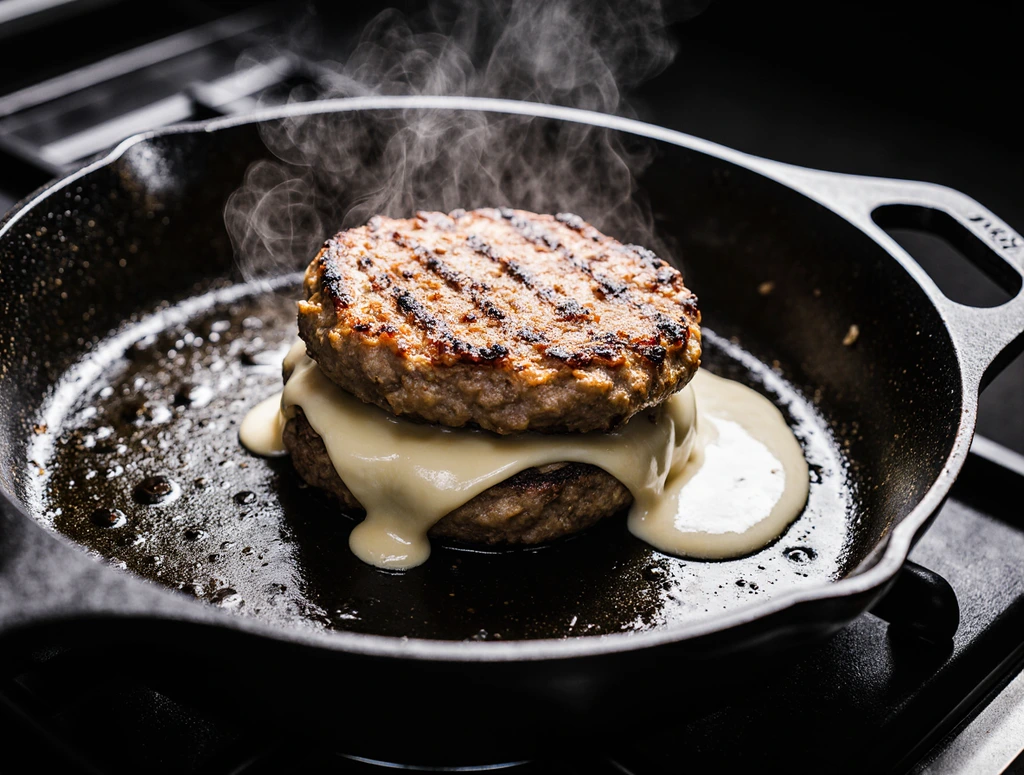
Perfect Cheeseburger Recipes: Blue Cheese & More
Hello, burger enthusiasts! I’m Khalid, your culinary companion with three decades of professional cooking experience. From my early days as a line cook to running my own kitchen, I’ve crafted thousands of burgers and learned what separates the extraordinary from the ordinary. Today, I’m excited to share my personal techniques for creating three incredible burger styles that will revolutionize your home cooking.
The cheeseburger stands as one of America’s greatest culinary contributions to the world. This seemingly simple combination of beef, cheese, and bun has evolved into countless variations, each offering unique flavors and textures. Through years of experimentation and refinement, I’ve developed foolproof methods for three distinct burger styles that consistently deliver outstanding results.
In this comprehensive guide, you’ll discover professional techniques for crafting juicy patties, selecting the right cheese combinations, and mastering the art of burger construction. We’ll dive deep into the science behind perfect burger-making, ensuring every bite delivers maximum flavor and satisfaction.
Table of Contents
- The Foundation: Understanding Great Burgers
- Essential Ingredients & Tools
- Classic Cheeseburger Recipe
- The Art of Smash Burgers
- Gourmet Blue Cheese Burgers
- Pro Tips for Perfect Patties
- Cheese Selection Guide
- Bun Selection & Preparation
- Toppings & Condiments
- Cooking Methods Compared
- Troubleshooting Common Issues
- Storage & Make-Ahead Tips
- Nutritional Considerations
- Frequently Asked Questions
The Foundation: Understanding Great Burgers {#foundation}
During my culinary journey across American kitchens, I’ve discovered that exceptional burgers begin with respecting the fundamentals. A perfect homemade cheeseburger recipe requires more than quality ingredients—it demands understanding how each element interacts to create culinary harmony.
Exceptional burgers share common traits: perfectly seasoned patties with caramelized crusts, cheese that enhances the beef’s flavor, fresh toppings providing textural variety, and sturdy buns that maintain integrity throughout the eating experience. My approach emphasizes the interconnection between these elements.
The primary error I observe in home kitchens involves excessive meat manipulation. Ground beef contains delicate protein structures that become dense when overworked. Professional technique requires gentle handling, forming patties with minimal pressure while maintaining structural cohesion.
Heat management represents another critical factor. Whether using outdoor grills or stovetop methods, controlling temperature determines your burger’s success. Proper heat application triggers the Maillard reaction, creating complex flavors that distinguish exceptional burgers from mediocre attempts.
Essential Ingredients & Tools {#ingredients-tools}
Premium Ground Beef Selection
Burger excellence begins with selecting proper ground beef. My preferred choice is ground chuck featuring an 80/20 lean-to-fat ratio—this proportion delivers optimal flavor richness and moisture retention while providing sufficient structure. Higher lean ratios like 90/10 produce disappointingly dry results that lack the juiciness essential for memorable burgers.
Fresh ground beef consistently outperforms frozen alternatives. Many quality butchers offer custom grinding services, ensuring peak freshness while allowing fat ratio customization. When frozen beef is your only option, complete refrigerator thawing followed by thorough patting dry becomes essential before patty formation.
Professional-Grade Equipment
Specific tools dramatically improve your burger-making capabilities. An accurate digital thermometer ensures precise doneness—target 160°F (71°C) for food safety compliance. Wide, thin spatulas facilitate flipping without patty damage, while burger presses or clean can bottoms excel for smash burger preparation.
Cast iron skillets represent my stovetop cooking preference due to superior heat retention and crust development properties. Grill users should prioritize clean, well-oiled grates to prevent sticking and ensure proper release.
Strategic Cheeseburger Choices
Cheese selection profoundly influences your burger’s final character. American cheese maintains its popularity through exceptional melting characteristics and balanced flavor that supports rather than overpowers beef. For complexity seekers, sharp cheddar, Swiss varieties, or bold blue cheese options offer distinctive taste profiles we’ll explore throughout this guide.
Classic Cheeseburger Recipe {#classic-cheeseburger}
Now we’ll tackle the cornerstone recipe—the classic cheeseburger recipe that has delighted burger enthusiasts for decades. This approach prioritizes technique and ingredient quality, allowing natural flavors to create the starring performance.
Ingredients (Serves 4):
- 1½ pounds ground chuck (80/20)
- 1 teaspoon kosher salt
- ½ teaspoon freshly ground black pepper
- 4 slices American cheese (or preferred melting cheese)
- 4 brioche hamburger buns
- 2 tablespoons butter, softened
- Lettuce leaves, tomato slices, and onion rings for toppings
- Preferred condiments (ketchup, mustard, mayo)
Method:
Step 1: Patty Formation Portion ground beef into four equal sections (approximately 6 ounces each). Gently shape into loose balls, then flatten into patties exceeding bun diameter—cooking shrinkage will occur. Use your thumb to create a center indentation; this technique prevents bulging and promotes even cooking.
Apply salt and pepper generously to both surfaces immediately before cooking. Advance seasoning draws out moisture and creates dense textures.
Step 2: Station Organization Arrange all toppings and prepare buns beforehand. This grilled cheeseburger recipe progresses quickly, making preparation essential for smooth execution.
Step 3: Patty Cooking Heat cooking surface to medium-high temperatures. Grill users should ensure clean, oiled grates. Stovetop cooks should use cast iron skillets without additional oil—beef fat provides adequate lubrication.
Position patties on hot surfaces and avoid spatula pressing—this forces out essential juices. Cook 3-4 minutes undisturbed, developing proper crust formation.
Step 4: Flip and Cheese Application Execute single flip when bottom achieves golden-brown coloring. Immediately place cheese atop each patty. Continue cooking 3-4 minutes for medium doneness, or until internal temperature reaches 160°F.
Step 5: Bun Preparation During patty resting, quickly toast bun cut-sides until golden. This prevents sogginess while adding textural variety.
Step 6: Construction Build burgers systematically: bottom bun, condiments, lettuce, cheesy patty, tomato, onion, additional condiments if desired, top bun.
This time-tested method has established homemade cheeseburgers as an American culinary staple, and mastering this foundation enables countless variations.
The Art of Smash Burgers {#smash-burgers}
The smash burger revolution has transformed contemporary burger culture, and rightfully so. This method, refined through fast-food innovation and elevated by modern culinary artisans, produces extraordinarily flavorful patties through maximum crust development. The best smash burger recipe leverages intense heat and Maillard reaction principles.
Mastering the Smash Method
Smash burgers succeed through pressing ground beef balls onto extremely hot cooking surfaces, maximizing meat-to-heat contact. This approach creates expanded browning surface area, generating deeper flavors and textural contrasts between crispy exteriors and succulent interiors.
Success requires fresh, never-frozen ground beef shaped into loose balls. Frozen beef contains ice crystals preventing proper smashing, while overly compressed meat resists correct spreading.
Smash Burger Recipe
Ingredients (Serves 4):
- 1 pound ground chuck (80/20), formed into 8 loose balls
- 1 teaspoon kosher salt
- ½ teaspoon black pepper
- 8 slices American cheese
- 4 potato buns or brioche buns
- Sliced onions, pickles, and signature sauce
Method:
Step 1: Station Setup Heat cast iron griddle or large skillet over medium-high heat until smoking. Ready your spatula plus secondary spatula or burger press.
Step 2: Ball Formation Gently shape ground beef into 8 loose balls, approximately 2 ounces each. Avoid tight packing—they should barely maintain cohesion.
Step 3: The Smash Execution Place 2-3 balls on hot surface with adequate spacing. Immediately apply firm downward pressure with spatula, creating maximum thinness—approximately ¼ inch thickness. Season exposed surfaces with salt and pepper.
Step 4: Patient Waiting Allow patties to cook undisturbed for 2-3 minutes until edges achieve deep browning and crispiness. Patience rewards you with crucial flavor development.
Step 5: Flip and Stack Flip carefully due to smash patty delicacy. Immediately apply cheese to half the patties, then stack non-cheese patties atop cheese-covered ones, creating double-stack burgers.
Step 6: Complete and Serve Cook additional 1-2 minutes until cheese achieves proper melting. Serve on toasted buns with preferred toppings.
Smash burgers excel through speed and flavor intensity. They’re ideal for weeknight cooking when you desire restaurant-quality results without extended time commitments. For additional burger creativity, explore these Italian cheeseburger variations incorporating Mediterranean influences.
Gourmet Blue Cheeseburger {#blue-cheese-burgers}

For those seeking a more sophisticated burger experience, blue cheese burgers offer complex, bold flavors that elevate the humble hamburger to gourmet status. The pungent, creamy characteristics of blue cheese pair beautifully with beef, creating a restaurant-worthy dish that’s surprisingly easy to execute at home.
Choosing the Right Blue Cheese
Not all blue cheeses are created equal for burger applications. Roquefort provides intense, sharp flavors but can be overpowering. Gorgonzola offers a milder, creamier profile that melts beautifully. For beginners, I recommend starting with a quality blue cheese crumble that distributes evenly and melts well.
Blue Cheeseburger Recipe
Ingredients (Serves 4):
- 1½ pounds ground chuck (80/20)
- 1 teaspoon kosher salt
- ½ teaspoon black pepper
- 4 ounces blue cheese, crumbled
- 4 brioche buns
- 2 tablespoons butter
- 1 large sweet onion, caramelized
- Mixed greens or arugula
- Balsamic glaze for drizzling
Blue Cheese Compound Butter
- 4 tablespoons unsalted butter, softened
- 2 ounces blue cheese, crumbled
- 1 clove garlic, minced
- 1 teaspoon fresh thyme
Instructions:
Step 1: Prepare Compound Butter Mix softened butter with blue cheese crumbles, minced garlic, and thyme. This compound butter will melt over the hot patty, distributing flavor evenly.
Step 2: Caramelize Onions Slice onions thinly and cook slowly over low heat with a pinch of salt until golden brown and sweet, about 20-30 minutes. This provides a sweet contrast to the sharp blue cheese.
Step 3: Form and Season Patties Create four 6-ounce patties using the gentle technique described earlier. Season with salt and pepper just before cooking.
Step 4: Cook the Burgers Use your preferred cooking method (grill or skillet) over medium-high heat. Cook for 4 minutes without moving, then flip. Immediately top each patty with a dollop of blue cheese compound butter.
Step 5: Rest and Assemble Allow patties to rest for 2-3 minutes, letting the compound butter melt and penetrate the meat. Assemble burgers with mixed greens, caramelized onions, and a drizzle of balsamic glaze.
Blue cheese burgers represent the perfect intersection of comfort food and fine dining. The key is balancing the bold flavors with complementary ingredients that enhance rather than compete.
Pro Tips for Perfect Patties {#pro-tips}
Through decades of professional burger crafting, I’ve refined techniques producing consistently exceptional results. These culinary secrets will revolutionize your home burger preparation.
The Minimal Handling Philosophy
Patty formation’s most vital aspect involves treating meat with extreme gentleness. Excessive ground beef manipulation develops protein structures, resulting in tough, dense outcomes. Shape patties using light pressure—just sufficient for basic cohesion.
The Center Depression Method
Always form shallow center depressions in each patty using your thumb. During cooking, proteins contract and force centers upward. The depression counteracts this natural tendency, maintaining uniform thickness throughout the cooking process.
Heat Management Excellence
Consistent temperature regulation distinguishes amateur from professional results. Grill users should establish heat zones—intense heat for initial searing, moderate heat for completion. Stovetop cooks must properly preheat pans and maintain steady temperatures throughout.
Strategic Salt Application
Season patties with salt immediately before cooking, never beforehand. Salt extracts moisture through osmosis, and premature salting creates dry, dense results. However, proper seasoning remains crucial—it separates exceptional burgers from bland alternatives.
The Single Flip Philosophy
Avoid multiple burger flipping temptations. Each flip releases valuable juices and interrupts crust development. One perfectly timed flip produces superior outcomes.
Cheese Selection Guide {#cheese-guide}

Choosing the right cheese can make or break your burger experience. Different cheeses melt differently and provide varying flavor profiles that can enhance or overpower your carefully crafted patty.
American Cheese: The Classic Choice
Despite its processed reputation, American cheese remains the gold standard for burgers due to its superior melting properties and neutral flavor that complements beef without competing. Quality American cheese melts evenly and provides that signature creamy texture.
Cheddar: Sharp and Satisfying
Sharp cheddar provides more complex flavors but requires careful temperature control to melt properly. It works exceptionally well with beef but can sometimes overwhelm delicate seasonings.
Swiss: Nutty and Mild
Swiss cheese offers subtle, nutty flavors and melts beautifully. It’s particularly good with mushroom toppings and provides an elegant alternative to more common choices.
Gourmet Options
For adventurous burger makers, consider aged Gruyère, smoked gouda, or fresh mozzarella. Each provides unique characteristics that can transform a simple burger into a gourmet experience.
Bun Selection & Preparation {#bun-guide}
The bun serves as more than just a vehicle for your burger—it’s an integral component that affects texture, flavor, and structural integrity. Poor bun choices can ruin even the most perfectly cooked patty.
Brioche: The Premium Choice
Brioche buns offer rich, buttery flavors and tender crumb that complements beef beautifully. Their slightly sweet profile balances savory elements while maintaining structural integrity.
Potato Buns: Soft and Sturdy
Potato buns provide exceptional softness while remaining sturdy enough to handle juicy patties and multiple toppings. They’re particularly popular for smash burgers due to their absorbent qualities.
Sesame Seed Buns: The Traditional Option
Classic sesame seed buns offer familiar flavors and good structural integrity. They’re readily available and work well for most burger applications.
Toasting Techniques
Always toast your buns to prevent sogginess and add textural contrast. Light toasting on a dry griddle or grill creates the perfect balance between crispy exterior and soft interior.
Toppings & Condiments {#toppings}
Strategic topping selection can elevate your burger from good to extraordinary. The key is balancing flavors, textures, and temperatures to create harmony rather than chaos.
The Fundamentals: Lettuce, Tomato, Onion
These classic toppings provide essential contrast—lettuce adds crunch and freshness, tomatoes contribute juiciness and acidity, and onions provide sharpness and bite. Use crisp lettuce varieties like iceberg or romaine, ripe but firm tomatoes, and sweet onions for best results.
Condiment Strategies
The right condiment can tie all elements together. Classic combinations like ketchup and mustard work because they provide acid and umami to balance rich beef and cheese. Mayonnaise adds richness and helps other flavors adhere to the burger.
Advanced Toppings
Consider bacon for smoky richness, avocado for creamy texture, or pickles for acidic crunch. Each topping should serve a purpose in the overall flavor profile.
For inspiration on creative topping combinations, explore these Italian burger recipes that showcase how international flavors can transform familiar ingredients.
Cooking Methods Compared {#cooking-methods}
Different cooking methods produce distinctly different results, and understanding these differences helps you choose the best approach for your desired outcome.
Grilling: The Classic Approach
Grilling provides smoky flavors and beautiful grill marks that many consider essential to the perfect burger experience. High heat creates excellent crust development, while the open flame adds complexity impossible to achieve indoors.
Setup your grill with different heat zones—high heat for initial searing, medium heat for finishing. Clean, well-oiled grates prevent sticking and ensure proper release.
Stovetop: Controlled and Consistent
Stovetop cooking in a cast iron skillet provides excellent heat retention and even cooking. This method offers more control over temperature and timing, making it ideal for beginners or when weather prevents outdoor grilling.
Griddle Cooking: Professional Results
Flat-top griddles provide maximum contact between meat and cooking surface, creating superior crust development. This is the preferred method for smash burgers and many restaurant operations.
Broiler Method: Indoor Alternative
When grilling isn’t possible, broiler cooking can provide similar results to grilling. Position racks properly and watch carefully to prevent overcooking.
Troubleshooting Common Issues {#troubleshooting}
Even experienced cooks encounter burger challenges. Understanding common problems and their solutions helps ensure consistent results.
Dry Burgers
Dry burgers typically result from overcooking, using lean ground beef, or over-handling the meat. Use 80/20 ground chuck, form patties gently, and cook to proper internal temperature without overdoing it.
Burgers Fall Apart
Crumbling burgers often stem from under-seasoning (salt helps bind proteins) or insufficient fat content. Ensure proper salt levels and avoid lean ground beef.
Uneven Cooking
Thick centers and thin edges cause uneven cooking. Form patties of consistent thickness with the dimple technique to ensure even results.
Soggy Buns
Prevent soggy buns by toasting them properly and considering bun shields like lettuce leaves between wet ingredients and bread.
Storage & Make-Ahead Tips {#storage}
Proper planning and storage techniques help you prepare components ahead of time while maintaining quality and food safety.
Patty Storage
Raw patties can be formed up to 24 hours in advance and refrigerated between parchment paper. For longer storage, freeze individually wrapped patties for up to three months.
Component Prep
Many burger components can be prepared ahead: caramelized onions keep for weeks refrigerated, compound butters freeze well, and properly stored buns maintain quality for several days.
Food Safety Considerations
Ground beef requires careful handling due to food safety concerns. Keep cold until cooking, cook to proper internal temperature (160°F), and don’t leave cooked burgers at room temperature for extended periods.
Nutritional Considerations {#nutrition}
While burgers are indulgent foods, understanding their nutritional profile helps you make informed decisions and modifications when desired.
Caloric Content
A typical cheeseburger contains 500-800 calories depending on size, cheese type, and condiments. Ground chuck (80/20) provides about 290 calories per 4-ounce serving before cooking.
Protein Benefits
Beef provides high-quality complete protein with all essential amino acids. A 4-ounce patty delivers approximately 24 grams of protein.
Healthier Modifications
Consider leaner ground beef blends, smaller portion sizes, or alternative proteins like turkey for reduced calorie options. However, remember that some fat is essential for flavor and juiciness. For healthier alternatives, check out this guide on turkey burger calories.
Quick Takeaways
• Quality ingredients matter most: Use 80/20 ground chuck, fresh buns, and good melting cheese • Handle meat gently: Overworking creates tough, dense patties • Create the dimple: Prevent bulging centers with a thumb depression • High heat for crust: Proper searing develops essential flavors through the Maillard reaction
• One flip rule: Multiple flips release juices and prevent proper browning • Season just before cooking: Salt draws out moisture if applied too early • Toast your buns: Prevents sogginess and adds textural contrast
Conclusion
Mastering cheeseburger creation transforms simple meals into extraordinary culinary experiences. Whether you gravitate toward classic American approaches, trendy smash burger methods, or sophisticated blue cheese variations, fundamental principles remain constant: premium ingredients, refined technique, and meticulous attention to detail.
Remember that exceptional burgers result from intentional choices—understanding how individual components contribute to final outcomes. From selecting optimal ground beef ratios to perfectly timing cheese applications, every decision influences your results.
Burger-making’s appeal lies in its universal accessibility. Using basic equipment and quality ingredients, any home cook can achieve results matching professional kitchens. Begin with these foundational recipes and techniques, then explore personal variations as confidence develops.
I encourage experimenting with all three styles presented, observing how different approaches affect texture, flavor, and overall enjoyment. Share your discoveries with family and friends—burgers naturally bring people together for memorable meals.
Which burger style appeals most to you, and what creative variations spark your interest? Share your experiences in the comments below, and spread this guide among fellow burger enthusiasts. For additional culinary inspiration, explore our classic cheeseburger collection and discover innovative approaches to elevate your burger repertoire.
Frequently Asked Questions
What’s the best fat content for burger patties? The optimal fat content is 80/20 (80% lean, 20% fat). This ratio provides enough fat for flavor and juiciness while maintaining structural integrity. Leaner ratios like 90/10 produce dry, flavorless burgers, while fattier ratios can fall apart during cooking.
How do I prevent my burgers from shrinking during cooking? Create a shallow dimple in the center of each patty with your thumb before cooking. As proteins cook and contract, they naturally push the center upward. The dimple compensates for this shrinkage, resulting in evenly shaped burgers.
Can I prepare burger patties in advance? Yes, you can form patties up to 24 hours ahead and refrigerate them between parchment paper layers. For longer storage, individually wrap and freeze patties for up to three months. Always bring refrigerated patties to room temperature for 15-20 minutes before cooking for even results.
What internal temperature should burgers reach for food safety? Ground beef should reach an internal temperature of 160°F (71°C) for food safety. Use a digital instant-read thermometer inserted horizontally into the thickest part of the patty to ensure accuracy.
Why do my homemade burgers always turn out dry? Dry burgers typically result from three main issues: using lean ground beef (choose 80/20 instead), overcooking (monitor internal temperature carefully), or over-handling the meat during patty formation (use a light touch when shaping).
Hello again, burger enthusiasts! I’m Khalid, and my three decades of culinary experience have taught me that burger perfection comes from understanding each component’s role. What’s your most challenging aspect of burger-making? Share your thoughts in the comments below, and let’s tackle those challenges together! Don’t hesitate to showcase your burger creations on social media and tag us—I genuinely enjoy witnessing your culinary journeys unfold. For additional gourmet recipes and professional cooking tips, visit our ultimate cheeseburger recipe collection and become part of our passionate home cooking community!
References
- Kenji López-Alt, J. “The Science of Good Cooking.” Serious Eats, 2019.
- McGee, Harold. “On Food and Cooking: The Science and Lore of the Kitchen.” Scribner, 2004.
- American Meat Institute. “Ground Beef Safety Guidelines.” 2023.
- USDA Food Safety and Inspection Service. “Safe Minimum Cooking Temperatures Chart.” 2024.
- Culinary Institute of America. “Professional Chef Techniques Manual.” 2022.
